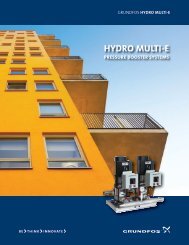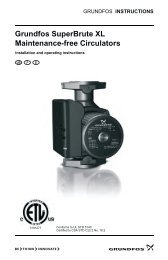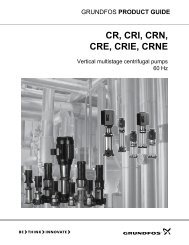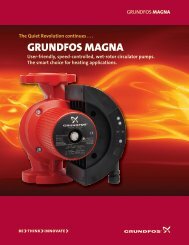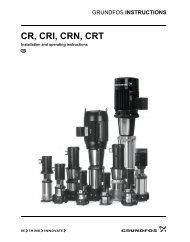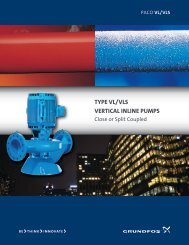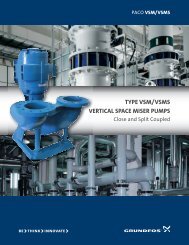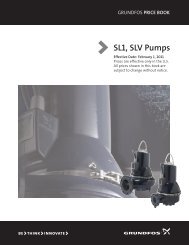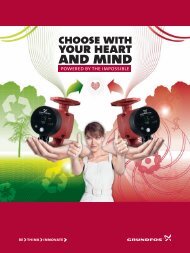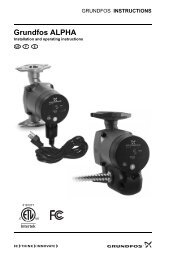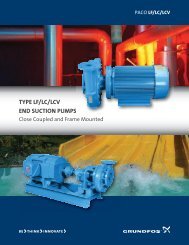BoosterpaQ® Grundfos CR-Booster Systems 60 Hz
BoosterpaQ® Grundfos CR-Booster Systems 60 Hz
BoosterpaQ® Grundfos CR-Booster Systems 60 Hz
You also want an ePaper? Increase the reach of your titles
YUMPU automatically turns print PDFs into web optimized ePapers that Google loves.
Product Description<br />
<strong>Grundfos</strong> <strong>Booster</strong>paQ ME <strong>Grundfos</strong> <strong>Booster</strong>paQ MEH <strong>Grundfos</strong> <strong>Booster</strong>paQ MES<br />
Example:<br />
Three pumps of equal<br />
size with MLE motors<br />
and a diaphragm tank.<br />
PFU 2000<br />
Example:<br />
Two half-size pumps<br />
with MLE motors, one<br />
mains-operated full-size<br />
pump and a diaphragm<br />
tank.<br />
PFU 2000<br />
Example:<br />
One pump with MLE<br />
motor, two mainsoperated<br />
pumps and<br />
a diaphragm tank.<br />
All pumps are of<br />
equal size.<br />
PFU 2000<br />
One pump<br />
in operation.<br />
H<br />
H set<br />
MLE MLE MLE<br />
One half-size<br />
pump with<br />
MLE motor in<br />
operation.<br />
H<br />
H set<br />
MLE<br />
MLE<br />
One pump<br />
with MLE<br />
motor in<br />
operation.<br />
H<br />
H set<br />
MLE<br />
Three pumps<br />
in operation.<br />
H<br />
H set<br />
<strong>Grundfos</strong> <strong>Booster</strong>paQ ME maintains a constant<br />
pressure through continuous variable<br />
adjustment of the speed of the pumps. The<br />
system performance is adjusted to the demand<br />
through cutting in/out the required number of<br />
pumps and through parallel speed control of the<br />
pumps in operation. Pump rotation is automatic<br />
and depends on load, time and fault.<br />
Q<br />
Q<br />
One full-size<br />
pump and one<br />
half-size pump<br />
with MLE<br />
motors in<br />
operation.<br />
H<br />
H set<br />
<strong>Grundfos</strong> <strong>Booster</strong>paQ MEH maintains a constant<br />
pressure through continuous variable<br />
and parallel adjustment of the speed of the<br />
two half-size pumps, while the full-size pump<br />
is mains-operated. The half-size pumps always<br />
start first. If the pressure cannot be maintained<br />
by one half-size pump, the second half-size<br />
pump and/or the full-size pump will be cut in.<br />
Pump rotation is automatic and depends on<br />
load, time and fault.<br />
Q<br />
Q<br />
One pump with<br />
MLE motor in<br />
operation and<br />
two pumps<br />
on mainsoperation.<br />
H<br />
H set<br />
<strong>Grundfos</strong> <strong>Booster</strong>paQ MES maintains a constant<br />
pressure through continuous variable<br />
adjustment of the speed of one pump. The<br />
other pumps are cut in/out on mains operation<br />
according to demand thus achieving a<br />
performance corresponding to consumption.<br />
The pump with MLE motor will always start<br />
first. Rotation among the pumps on mains<br />
operation is automatic and depends on load,<br />
time and fault.<br />
Q<br />
Q<br />
<strong>Grundfos</strong> <strong>Booster</strong>paQ MF <strong>Grundfos</strong> <strong>Booster</strong>paQ MFH <strong>Grundfos</strong> <strong>Booster</strong>paQ MS<br />
Example:<br />
Four pumps and a<br />
diaphragm tank. All<br />
pumps are of equal<br />
size.<br />
PFU 2000<br />
Example:<br />
Two half-size pumps,<br />
two full-size pumps,<br />
and a diaphragm tank.<br />
PFU 2000<br />
Example:<br />
Four pumps and<br />
a diaphragm tank.<br />
All pumps are of<br />
equal size.<br />
PFU 2000<br />
One pump<br />
in operation<br />
via variable<br />
frequency<br />
drive.<br />
One pump<br />
in operation<br />
via variable<br />
frequency<br />
drive and<br />
two pumps<br />
on mains<br />
operation.<br />
H<br />
Hset<br />
H<br />
Hset<br />
<strong>Grundfos</strong> <strong>Booster</strong>paQ MF maintains a constant<br />
pressure through continuous variable adjustment<br />
of the speed of one pump. The other<br />
pumps are mains-operated (on/off) according<br />
to the demand thus achieving a system size<br />
corresponding to the consumption. The pump<br />
controlled by the variable frequency drive will<br />
always start first. Pump rotation is automatic<br />
and depends on load, time and fault. All pumps<br />
are controlled by the variable frequency drive in<br />
rotation.<br />
<strong>Grundfos</strong> <strong>Booster</strong>paQ MSH<br />
Example:<br />
One half-size<br />
pump, three fullsize<br />
pumps and a<br />
diaphragm tank.<br />
PFU 2000<br />
Q<br />
Q<br />
One half-size<br />
pump in operation<br />
via variable<br />
frequency drive.<br />
One full-size<br />
pump in operation<br />
via variable<br />
frequency drive<br />
and one fullsize<br />
pump on<br />
mains operation.<br />
H<br />
Hset<br />
<strong>Grundfos</strong> <strong>Booster</strong>paQ MFH maintains a constant<br />
pressure through continuous variable<br />
adjustment of the speed of the one half-size<br />
pump. The rest of the pumps are mains-operated.<br />
A half-size pump controlled by the variable<br />
frequency drive will always start first. If the<br />
pressure cannot be maintained by one half-size<br />
pump, the second half-size pump and/or the<br />
full-size pump will be cut in on mains-operation.<br />
Rotation between the half-size pumps is<br />
automatic and depends on load, time and fault.<br />
The full-size pumps on mains power are automatically<br />
rotated among themselves.<br />
Example:<br />
One half-size<br />
pump in<br />
operation.<br />
H<br />
Hstop<br />
Hset<br />
H<br />
Hset<br />
Q<br />
Q<br />
Q<br />
One pump<br />
in operation.<br />
Three<br />
pumps in<br />
operation.<br />
H<br />
Hstop<br />
Hset<br />
H<br />
Hstop<br />
Hset<br />
<strong>Grundfos</strong> <strong>Booster</strong>paQ MS maintains a pressure<br />
range by cutting in/out the required number<br />
of pumps. The operating range of the pumps<br />
will lie between the lines Hset and Hstop (cutout<br />
pressure). The cut-out pressure cannot be<br />
set but is calculated automatically. Rotation<br />
H<br />
among the pumps is automatic and depends<br />
on load, time, and fault.<br />
Example:<br />
One half-size<br />
pump and<br />
one full-size<br />
pump in<br />
operation.<br />
H<br />
Hstop<br />
Hset<br />
Q<br />
Q<br />
Q<br />
<strong>Grundfos</strong> <strong>Booster</strong>paQ MSH maintains a pressure range by cutting in/out the half-size pump and the full-size pumps. The half-size pump will always<br />
start first. The half-size pump will be cut out again when a full-size pump is cut in. The operating range of the pumps will lie between the lines Hset<br />
and Hstop (cut-out pressure). The cut-out pressure cannot be set but is calculated automatically. Rotation among the full-size pumps is automatic and<br />
depends on load, time and fault.<br />
5



